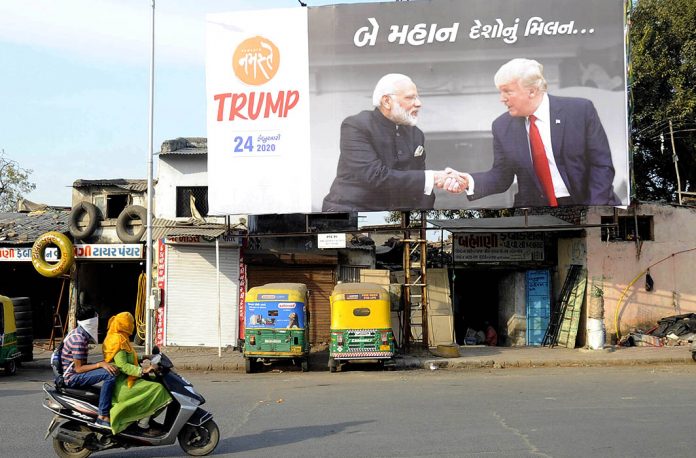
By Nupur Dogra
As the US president arrived at Ahmedabad today he received a warm welcome to a beautified and a “proper” modern city. Ahmedabad, the largest city of a state that is applauded for its development model, has been preparing for this visit of Donald Trump since past few months.
The Gujarat government has built a wall along the road connecting the Sardar Vallabhbhai Patel International Airport to Indira Bridge, apparently to conceal the slum area on the likely route that US President Donald Trump and Prime Minister Narendra Modi would take for the road show today. Reportedly, the Ahmedabad Municipal Corporation has spent approximately Rs 50 crores in the beautification drive which included building of a half a kilometer long wall stretch that leads to Gandhi Nagar to cover up any sight that may hurt the eyes.
There have been reports of at least 45 families living in slums near the newly built Motera stadium being served notice to evict their homes by the municipal corporation just few days before the visit of US president. Though the corporation has denied any connection of eviction of slum dwellers near the stadium to the high profile visit, but it is not difficult to comprehend the reason behind this sudden eviction drive.
However, beautification drives are not a new phenomenon. Whenever someone of international importance visits our country, the authorities try their best to present the perfect scenery and paint a fancy picture of an abundant India. And why should we not? After all, everyone wants to be presentable in the eyes of their guests. It’s our pride that is at stake. And what are a few slum dwellers and their daily lives in front of a nation’s pride?
In 1983, when the Commonwealth Heads of Government Meeting (CHOGM) took place in New Delhi, huge walls were raised to cover poverty struck areas. This happened under a prime minister who rose to power on the slogan of “Gareebi hatao” meaning “removing poverty” in 1971. But, in 1983, to please the eyes, removing the poor from the sight seemed more convenient. Recently when Trump’s daughter Ivanka visited Hyderabad in 2017, the police rounded up beggars from roads and detained them. Such “beautification drives” have been a common practice in Indian history.
The government has been putting all its efforts to make President Trump’s visit a huge success. Today, the US president concluded his speech saying that “India’s true strength is not in its books or nature but in the millions of hearts that beat in this nation”. Out of the 1.33 billion hearts that beat in India, it is not tough to say who all are not included in his “million hearts” statement. He may have referred to the rich and the poor while praising the soul and spirit of India. But the Indian poor find themselves displaced and disowned by their own country whenever an important guest arrives.
Why are we so ashamed of our own people? Poverty exists in our country and the gap between the rich and the poor has been widening through the years. These two facts are repeated in every economic survey of India. Slums exist in India, beggars exist in India, and poverty exists in India. For how long can we keep hiding them under a carpet or beyond a wall? As the gap between the rich and poor widens how many more walls are we going to build? How many hearts are we ready to disown? As the proud Indian is enthused with Trump’s visit to India, I don’t wish to burst his/her pride bubble. But we must think for how long are we ready to shut our eyes to the unfortunate truth to live few transient fortunate lies.
In the end I would leave you with two lines from the famous Hindi poet Dushyant Kumar,
“कहाँ तो तय था चराग़ाँ हर एक घर के लिये, कहाँ चराग़ मयस्सर नहीं शहर के लिये” which means “where It was decided that lamps would lit up every dwelling, there, even a single lamp for the whole town is a rare sight.”

